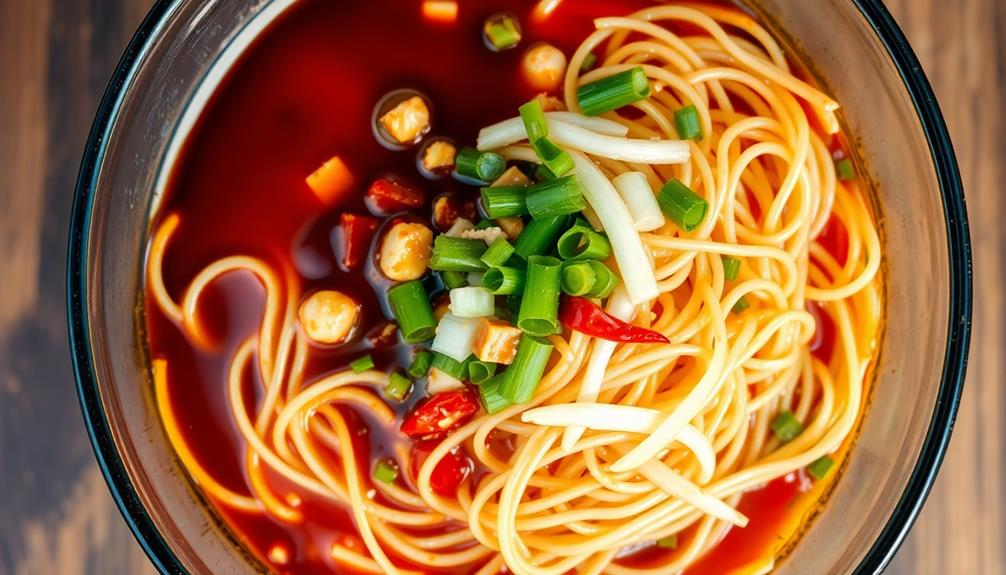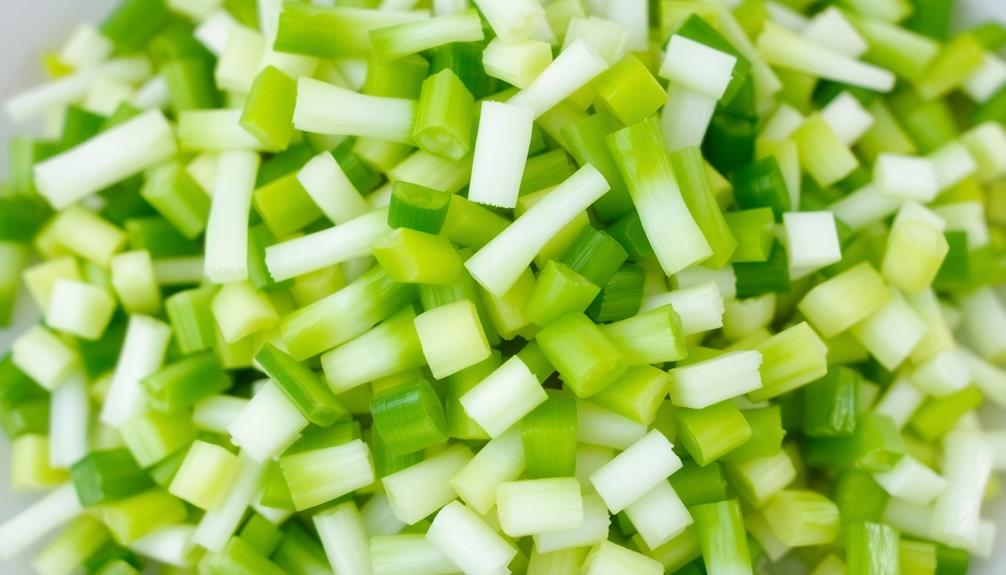Sichuan cold noodles are a deliciously refreshing dish you've gotta try! With roots tracing back centuries, these noodles from southwestern China blend spicy, tangy, and fresh flavors that'll make your taste buds dance. The key is cooking the noodles just right, then tossing them in a vibrant sauce packed with garlic, ginger, and Sichuan peppercorns. Top it off with crunchy veggies and herbs for a party in your mouth! It's the perfect summer treat, but you can enjoy this versatile dish year-round. Ready to learn more about this beloved specialty? Just keep reading!
Key Takeaways
- Sichuan Cold Noodles have origins tracing back to the Han Dynasty and are a beloved specialty dish of Sichuan province, known for their spicy and tangy flavors.
- The dish features Chinese wheat noodles tossed in a sauce of soy sauce, vinegar, sesame oil, garlic, and chili oil, creating a refreshing and versatile summer meal.
- Sichuan Cold Noodles are characterized by a combination of chewy noodles, crunchy vegetables, and bold flavors, providing a contrasting texture and temperature experience.
- The dish is typically garnished with fresh herbs like scallions, enhancing the visual appeal and adding to the overall taste and enjoyment.
- Sichuan Cold Noodles have gained popularity beyond Sichuan province and are now featured in summer menus at restaurants, showcasing the dish's versatility and ease of preparation.
History
Sichuan cold noodles have a rich history rooted in the culinary traditions of southwestern China. For centuries, the people of Sichuan province have crafted this dish, perfecting the balance of flavors and textures. The origins can be traced back to the Han Dynasty, when noodle-making techniques were first developed in the region.
Over time, the recipe has evolved, incorporating local ingredients like chili peppers, Sichuan peppercorns, and fragrant herbs.
Today, Sichuan cold noodles are a beloved specialty, enjoyed throughout the province and beyond. The dish's popularity has even spread internationally, delighting food enthusiasts worldwide.
What makes it so special? The noodles' firm bite, the tangy-sweet sauce, and the refreshing crunch of vegetables all come together in a harmonious symphony of flavors.
Whether you're a long-time fan or new to this culinary treasure, diving into a bowl of Sichuan cold noodles is a journey you won't soon forget.
Recipe
Sichuan Cold Noodles are a refreshing and flavorful dish that originated in the Sichuan province of China. The combination of chewy noodles, savory seasonings, and a tangy dressing creates a delightful balance of textures and flavors.
The key to making these noodles is to use the right type of noodles and to ensure that the dressing is well-balanced and coats the noodles evenly. This dish is perfect for hot summer days, as the chilled noodles provide a cooling and satisfying meal.
Ingredients:
- 8 oz. Chinese wheat noodles
- 2 tablespoons soy sauce
- 1 tablespoon rice vinegar
- 1 tablespoon sesame oil
- 1 tablespoon chili oil (or to taste)
- 1 teaspoon sugar
- 1 clove garlic, minced
- 1-inch piece of ginger, grated
- 2 scallions, thinly sliced
- 1/4 cup roasted peanuts, chopped
- 1/4 cup fresh cilantro, chopped
Instructions:
Cook the noodles according to the package instructions, then rinse with cold water and drain thoroughly.
In a large bowl, whisk together the soy sauce, rice vinegar, sesame oil, chili oil, and sugar. Add the cooked noodles, garlic, ginger, scallions, peanuts, and cilantro, and toss everything together until the noodles are evenly coated with the dressing.
For the best results, let the noodles chill in the refrigerator for at least 30 minutes before serving. This allows the flavors to meld and the noodles to become thoroughly chilled.
Serve the Sichuan Cold Noodles garnished with additional peanuts and cilantro, if desired. Enjoy the refreshing and flavorful dish on a hot summer day.
Cooking Steps
First, you'll want to bring a pot of water to a boil.
Once it's bubbling, go ahead and toss in those noodles – just give 'em a quick rinse when they're done.
Next, let's mix up that tasty sauce and get ready to coat those noodles.
Step 1. Bring Water to a Boil

Bring a large pot of water to a vigorous boil over high heat. Once the water is bubbling away, you'll be one step closer to slurping up those delicious Sichuan cold noodles! Just keep an eye on the pot – you'll know it's ready when the water is rolling and steaming.
Now, gently add the noodles to the boiling water. Don't be shy, toss them right in! Let the noodles cook for about 2-3 minutes, stirring occasionally, until they're tender but still have a slight bite. You want them to be just right – not too soft, not too crunchy.
Drain the noodles in a colander and give them a quick rinse with cool water to stop the cooking. This helps them achieve that perfect, slippery texture we're going for.
Alright, time to move on to the next step! With your noodles cooked and cooled, you're well on your way to enjoying a refreshing Sichuan cold noodle dish.
Step 2. Drain and Rinse Noodles

Once the noodles have finished cooking, it's time to drain and rinse them.
You'll want to carefully transfer the noodles to a colander in the sink. Be gentle as you scoop them out – you don't want to break any of those delicate strands!
Once they're all in the colander, run some cool water over the noodles to stop the cooking process. Swish them around with your hands to ensure they're thoroughly rinsed. This will wash away any excess starch and prevent the noodles from sticking together.
Shake the colander a few times to let the water drain off, then transfer the noodles to a clean bowl.
You're one step closer to enjoying those tasty Sichuan cold noodles! Just wait until you try the flavorful sauce – it's going to be so worth the effort. The combination of the spicy, numbing Sichuan peppercorns with the umami-rich soy sauce is truly irresistible. Plus, if you love noodles, you’ve got to check out the zhajiangmian noodle recipe for another comforting dish that’s packed with bold flavors. Trust us, once you master these, you’ll have a whole new appreciation for authentic Chinese cuisine!
Step 3. Mix Sauce Ingredients

With the noodles rinsed and ready, it's time to whip up the flavorful Sichuan-style sauce. In a medium bowl, you'll combine the savory soy sauce, tangy black vinegar, and a touch of honey to balance the flavors.
Don't forget to add the fragrant sesame oil – it'll give the sauce a delightful nutty aroma.
Next, mince up some fresh garlic and ginger. These aromatic ingredients will add a real zing to the sauce. Once they're all chopped, toss them right into the bowl.
Now, for a little heat, stir in some chili oil or Sichuan peppercorns. You can add as much or as little as you like, depending on your spice preference.
Give everything a good mix until the sauce is smooth and well-blended. Taste it and adjust any seasonings as needed.
With the sauce ready, you can now toss it with the noodles for a delicious cold Sichuan dish! Get ready for some serious flavor in every slurpworthy bite. To add some extra texture and flavor, consider topping the cold Sichuan dish with some thinly sliced cucumbers or a sprinkle of toasted sesame seeds. If you’re looking for a heartier meal, try serving the dish alongside some crispy chinese stirfried noodles for a satisfying combination of textures. No matter how you choose to enjoy it, this dish is sure to be a hit with anyone who loves bold and spicy flavors.
Step 4. Toss Noodles With Sauce Mixture

Alright, let's get those noodles dressed in that flavor-packed sauce! First, grab your bowl of perfectly cooked, chilled noodles.
Now, pour the savory sauce mixture over the top. Don't be shy – really coat those noodles well! Gently toss everything together using your chopsticks or a pair of tongs. You want to make sure every strand is nicely glazed in that delicious sauce.
Once the noodles are thoroughly combined, take a moment to admire your handiwork. Doesn't it look absolutely mouthwatering? The glossy noodles, the vibrant colors – it's a feast for the eyes!
Now, it's time for the best part: digging in. Go ahead and give it a good mix one more time, then start slurping away. Trust me, those flavors are gonna dancing on your tastebuds. So get ready to enjoy every slurpy, saucy bite of your Sichuan cold noodle masterpiece!
Step 5. Garnish With Chopped Scallions

Garnished with vibrant green scallions, the Sichuan cold noodles now burst with freshness. Finely chop a handful of fresh scallions, cutting them on the diagonal for an elegant presentation.
Sprinkle the chopped scallions generously over the noodles, allowing their crisp texture and mild onion flavor to complement the tangy dressing. The scallions' bright color will also make the dish visually appealing, inviting you to take that first tasty bite.
Be sure to distribute the scallions evenly so every forkful includes their refreshing presence. The scallions' grassy notes will uplift the overall flavor, cutting through the richness of the sauce.
This simple garnish takes mere moments but elevates the Sichuan cold noodles, turning them into a vibrant and complete dish. With the scallions in place, your cold noodles are now ready to enjoy on a hot summer day.
Final Thoughts
Sichuan Cold Noodles are a refreshing and versatile dish that can be enjoyed year-round. The combination of chewy noodles, crunchy veggies, and the bold, spicy sauce makes for a truly delightful experience.
Don't be afraid to get creative with your toppings – the possibilities are endless! You could add shredded chicken, sliced beef, or even some crispy fried tofu for extra protein. And don't forget to generously sprinkle on those fresh, fragrant scallions. They add a lovely pop of color and a delightful onion flavor that ties everything together.
When you're ready to serve, be sure to toss the noodles with the sauce until they're evenly coated. This ensures each bite is bursting with that signature Sichuan flavor.
Savor every slurp and enjoy the contrast of temperatures and textures. Sichuan Cold Noodles are sure to become a new summertime favorite, or even a year-round go-to meal.
Frequently Asked Questions
What Is the Origin of Sichuan Cold Noodles?
You'll find the origin of this delectable dish in the Sichuan province of China, where the bold flavors and spices of the region have long been the inspiration for its unique taste.
How Long Can Sichuan Cold Noodles Be Stored?
You can typically store Sichuan cold noodles in the refrigerator for 3-5 days. The key is to keep them properly sealed and chilled to maintain their texture and flavor. Proper storage is essential for enjoying these delicious noodles.
Can I Use Different Types of Noodles for This Dish?
You can absolutely use different types of noodles for this dish. The key is to choose a noodle that will hold up well to the cold temperature and bold flavors of the dish. Experiment with various noodle varieties to find your favorite.
What Are the Health Benefits of Sichuan Cold Noodles?
The health benefits of this dish can include increased fiber intake from the noodles, vitamins and minerals from the vegetables, and an anti-inflammatory effect from the Sichuan peppercorns. Enjoy this flavorful and nutritious meal.
Can I Add or Substitute Ingredients in This Recipe?
Absolutely! You can customize the recipe to your liking. Feel free to add or substitute ingredients that suit your dietary preferences or taste buds. Get creative and experiment to find the perfect flavor combination for you.









